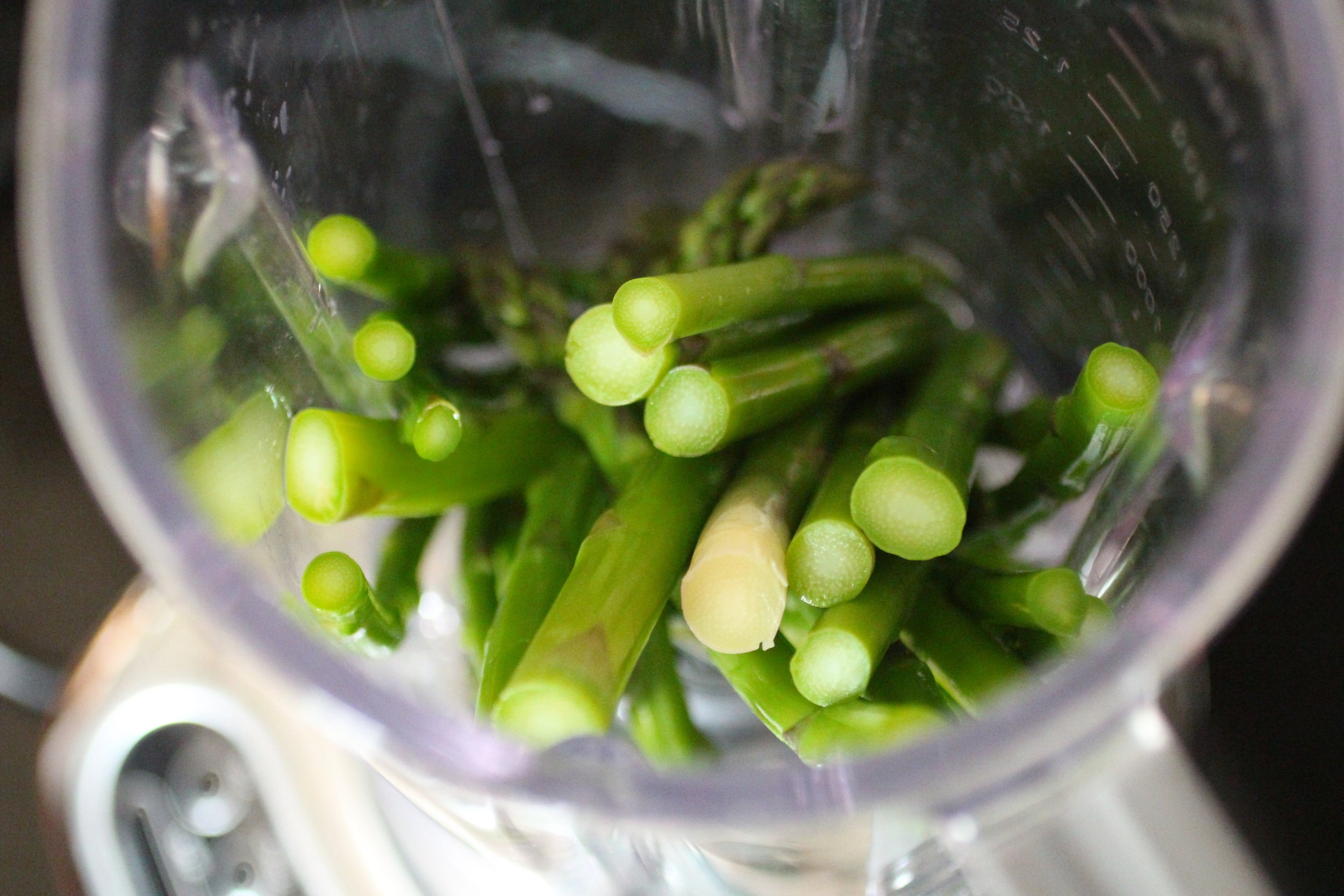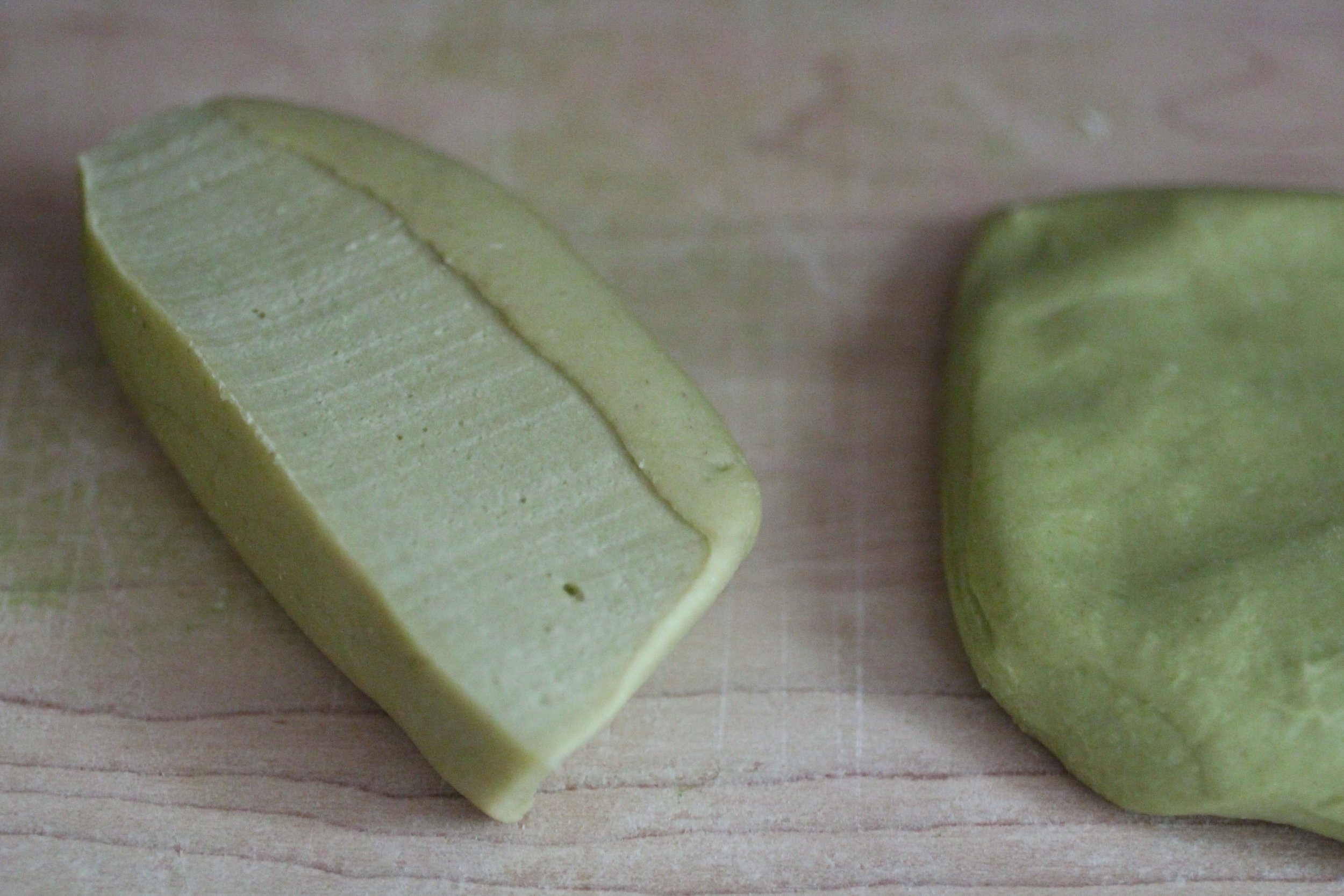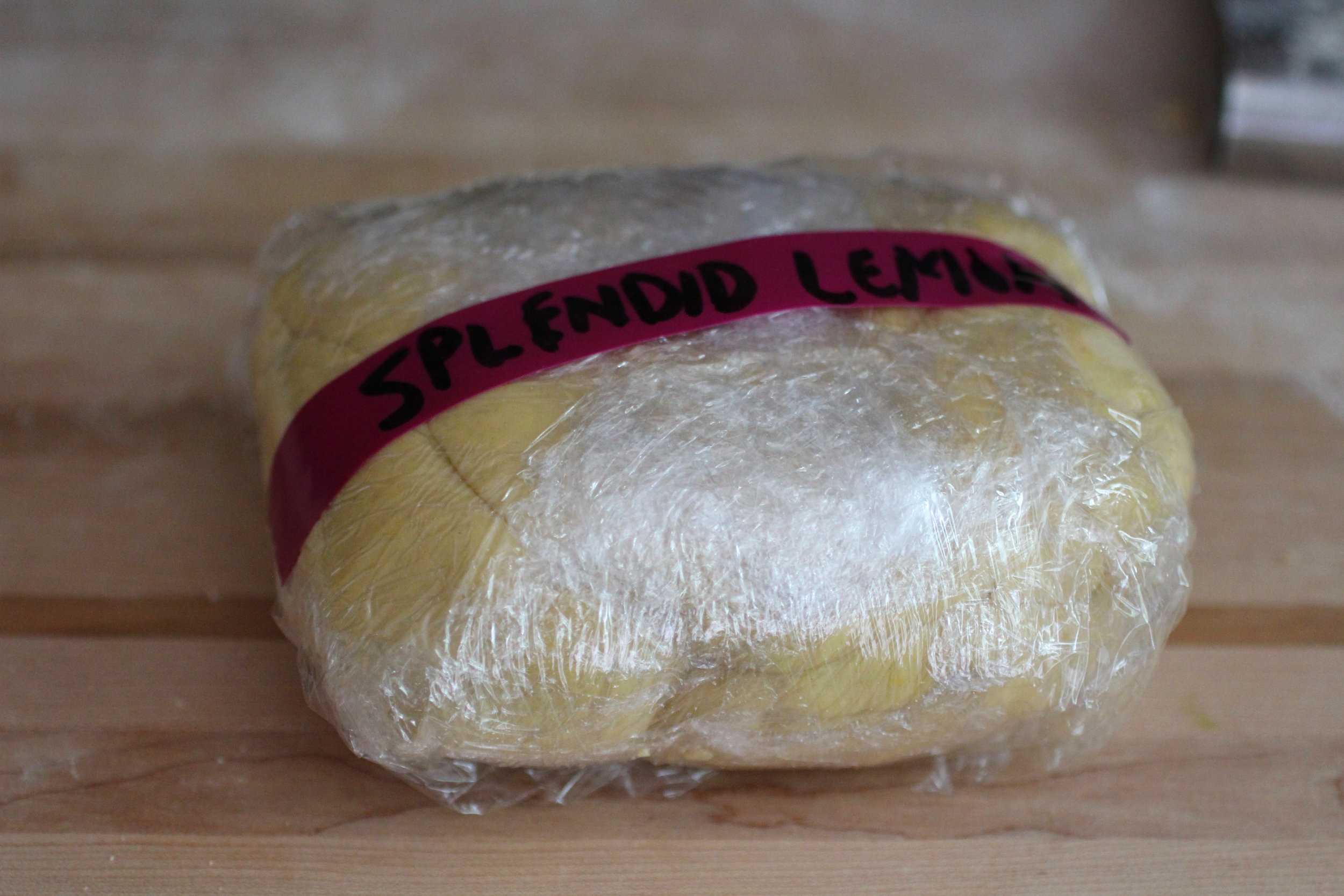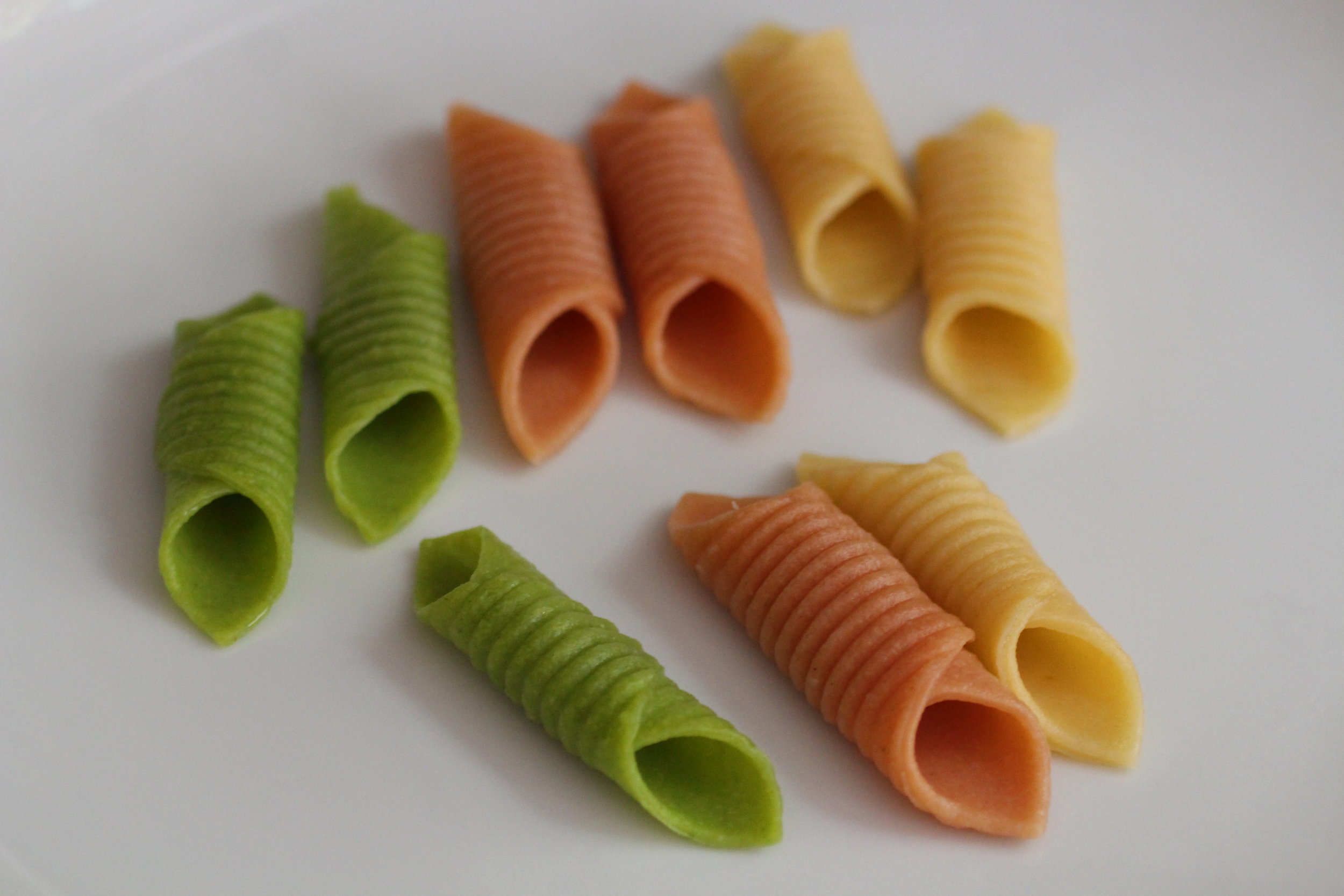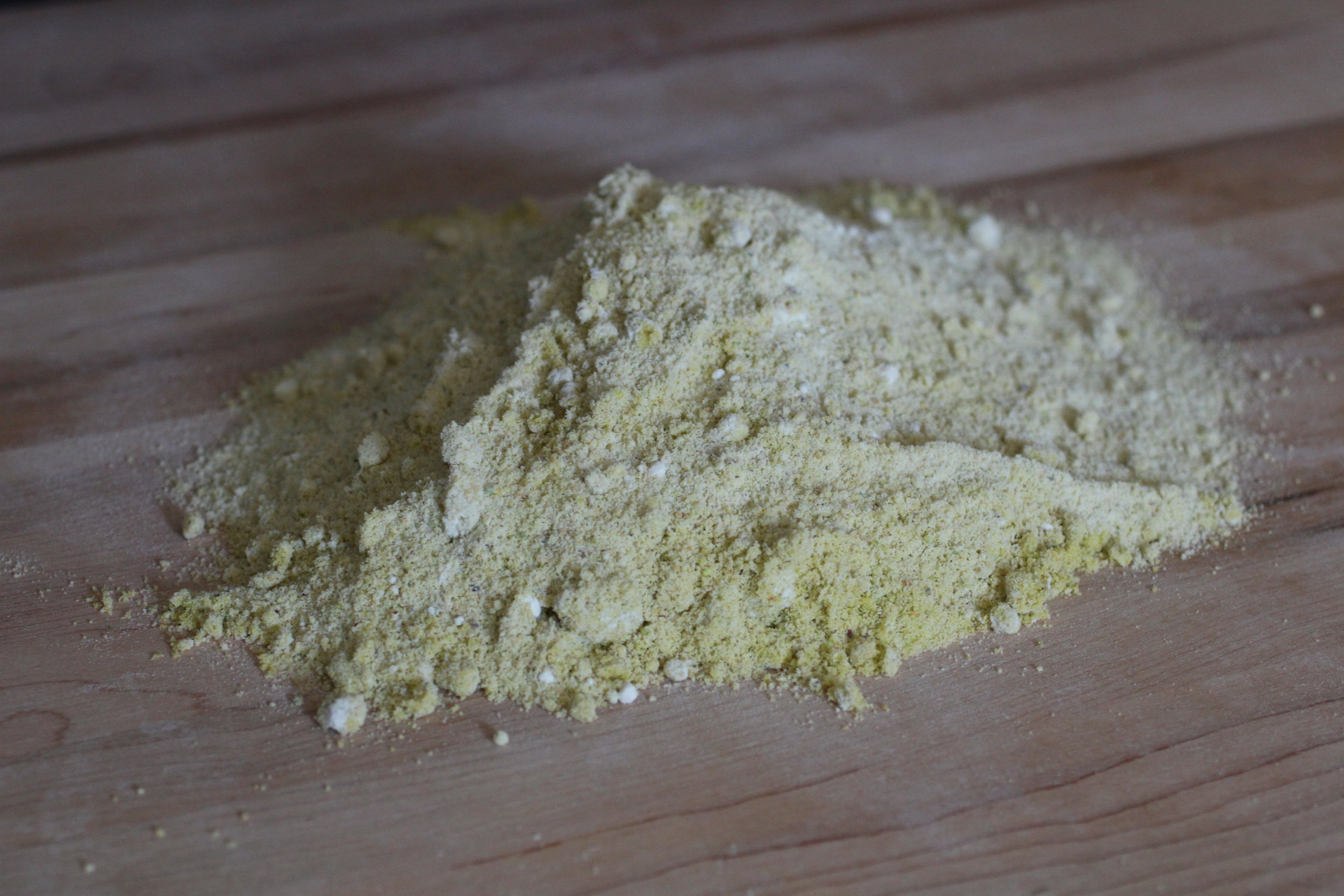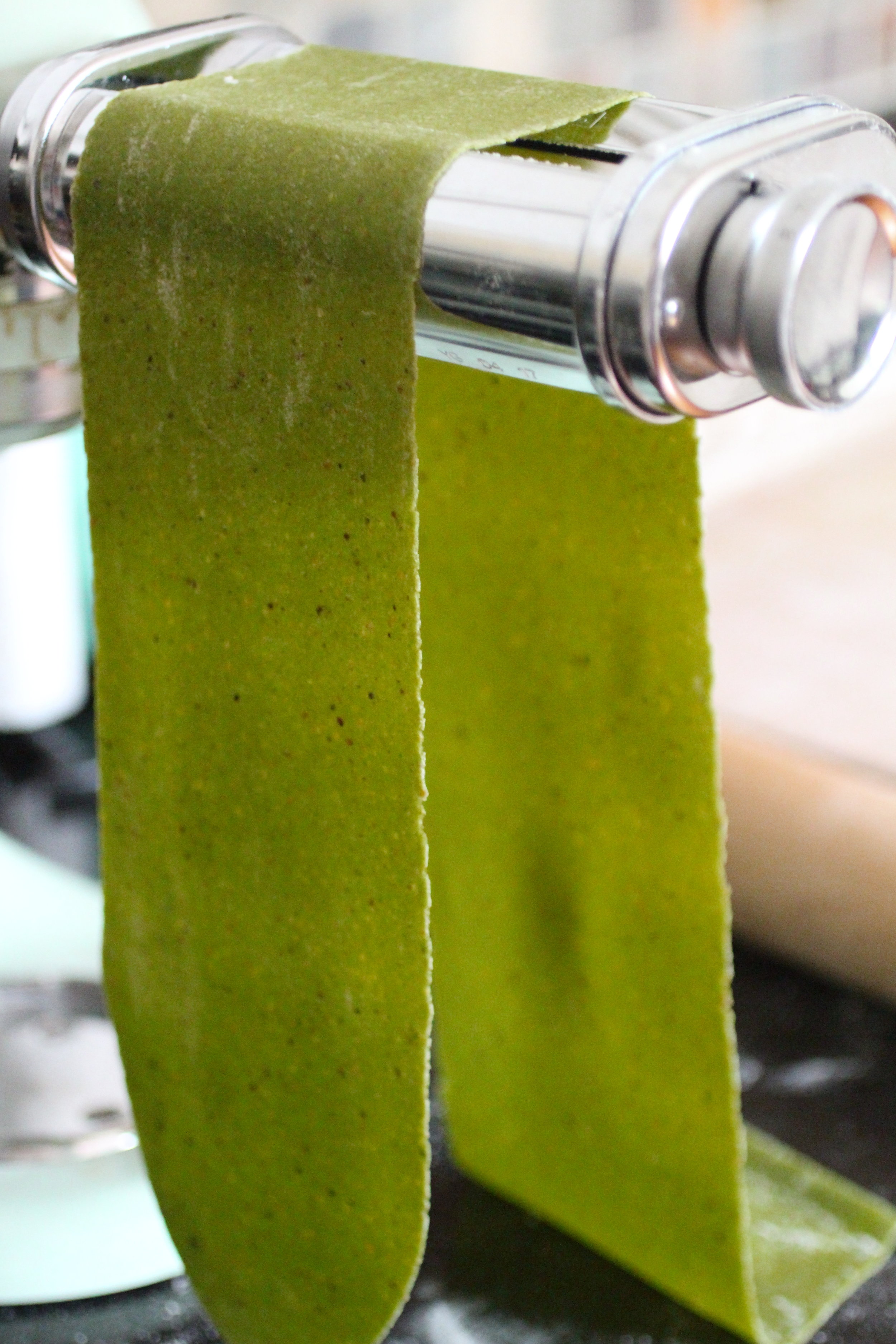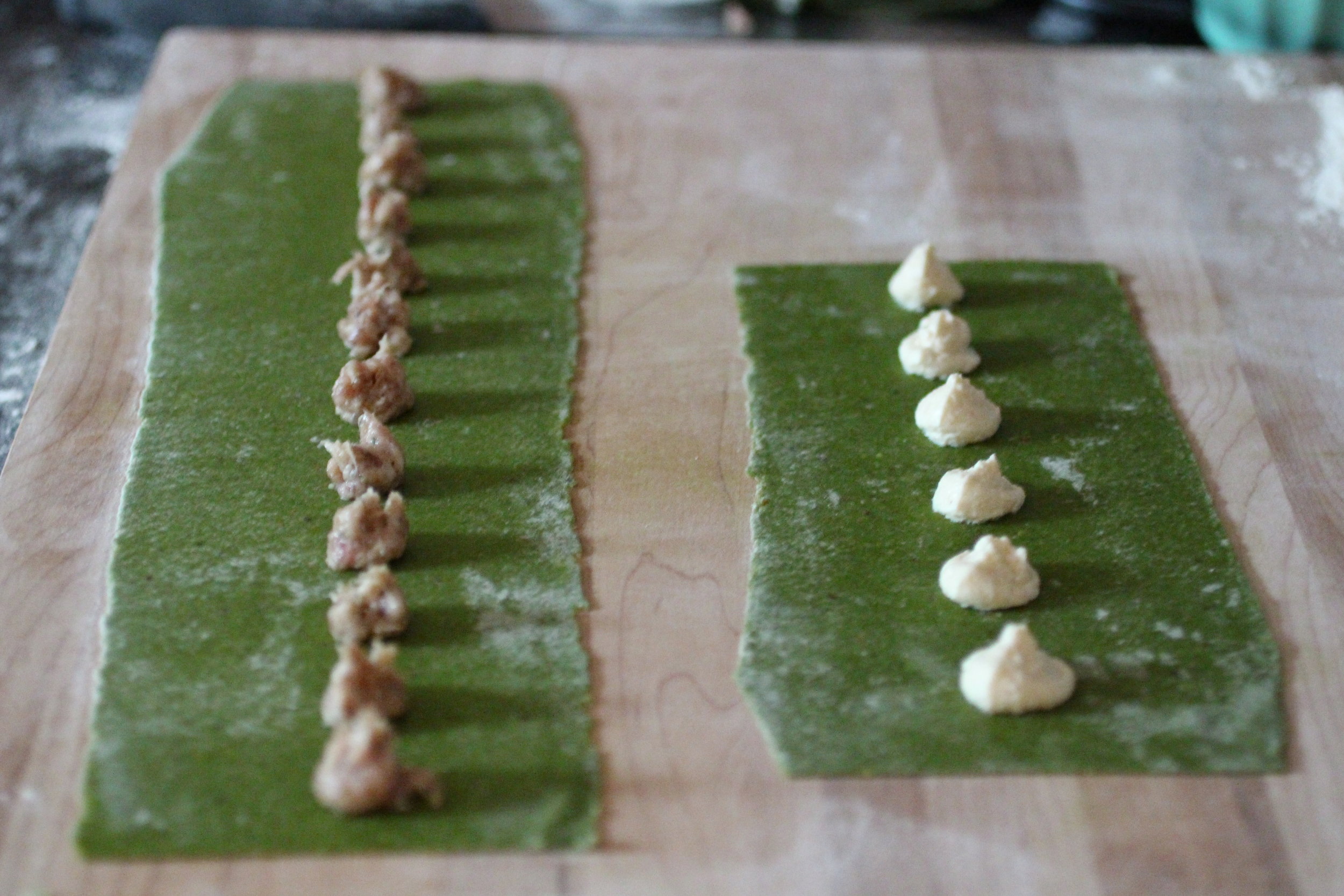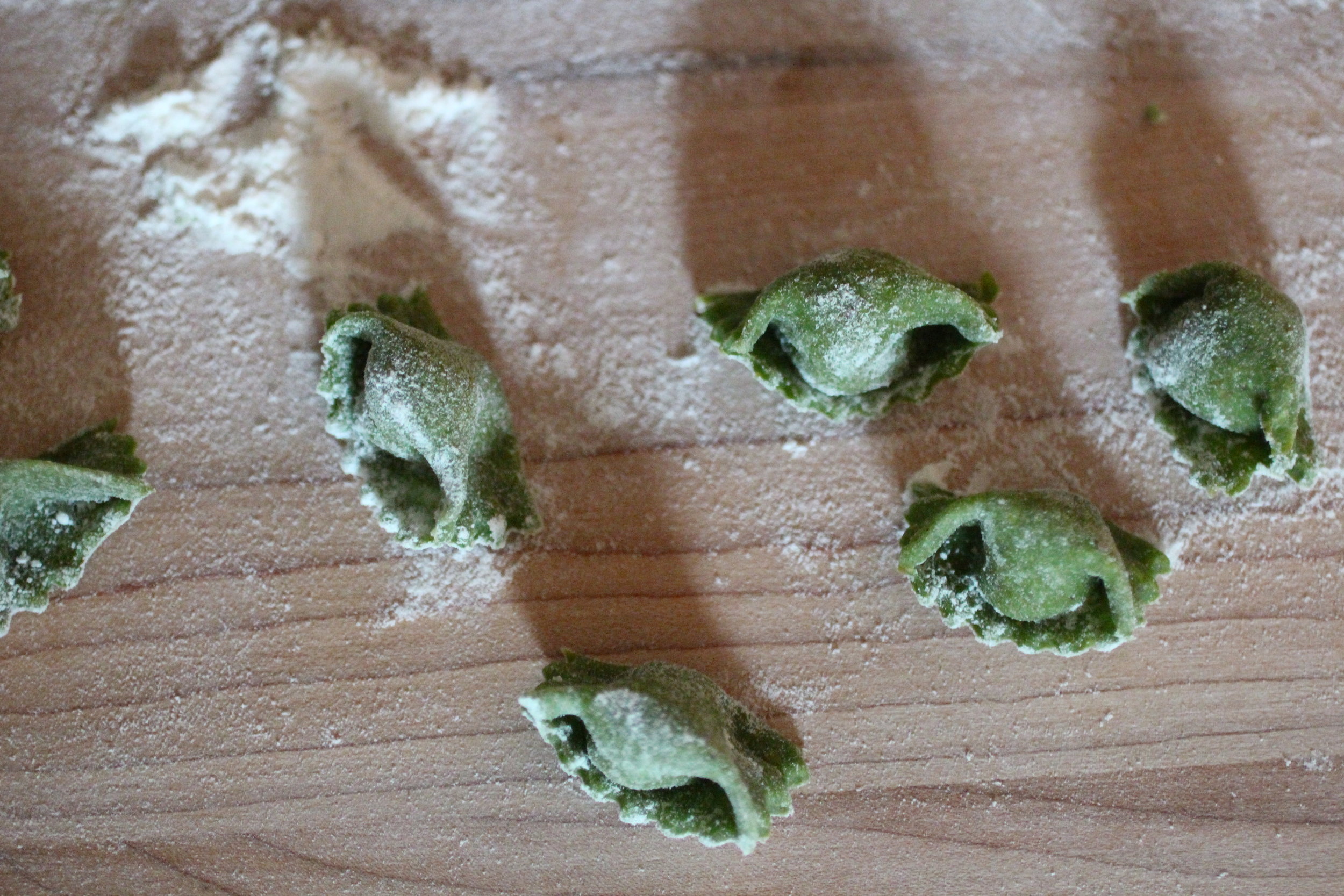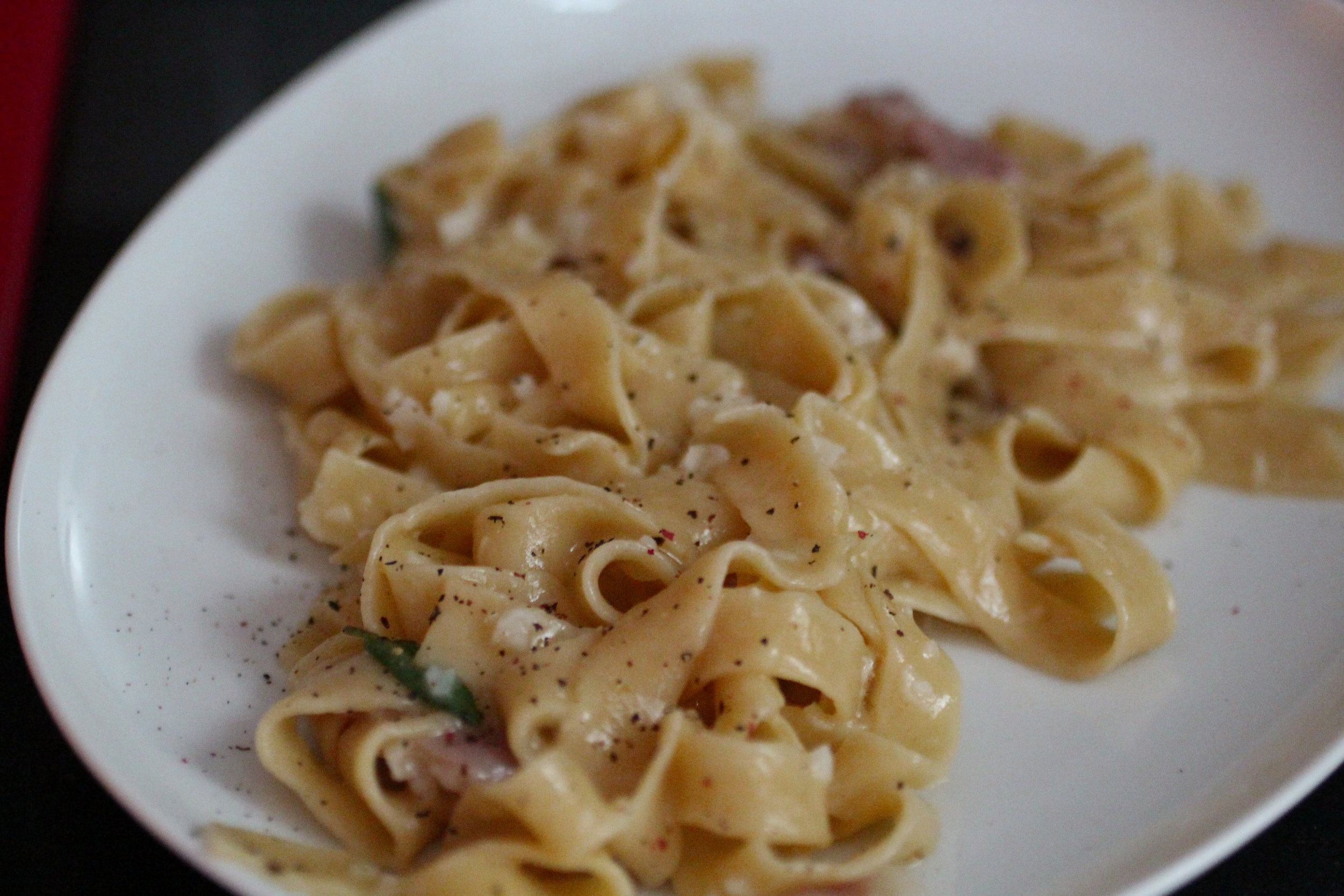Culinary Studio 520
04.18.18 / Orecchiette with Broccoli Rabe
500g Semolina Flour / 250g water / 50%
The pasta had a nice tooth and strong plasticity, and the emulsified sauce of pasta water, olive oil and Parmesan cheese coated well.
What is the difference between Semolina and Durum Flour?
Durum wheat is a protein-rich hard wheat that attributes yellow color and nutty flavor to pasta dough. Semolina refers to the coarsely milled endosperm of durum wheat where the bran and germ have been removed, resulting in a toothsome dough (Marchetti). Refined or remilled durum wheat is known as durum flour and yields a soft or delicate dough. Below are the specific durum wheat flours used for testing doughs.
Semolina: Bob’s Red Mill Semolina Flour
Ingredients: Enriched durum wheat
Serving Size: 42g = 5g protein
Gluten Strength: Moderate
Elasticity: Low
Durum Flour: Caputo Semola Rimacinata Di Grano Duro
Ingredients: Remilled durum wheat
Serving Size: 30g = 3g protein
Gluten Strength: Strong
Elasticity: Low
04.22.18 / Farfalle
400g 00 + 100g Semolina Flour / 250g water / 50%
The dough and shaped pasta were very smooth with no texture and moderate plasticity. Cooked pasta yielded a slimy mouthfeel.
How does the addition of whole eggs to 00 flour affect the texture of dough?
Egg whites add protein and water, and yolks add protein and fat (Vetri). The addition of whole eggs to 00 flour increases the overall protein content and strengthens the structure of the dough. In addition, eggs improve nutrition, color and cooking behavior (Alamprese). Because 00 flour is milled from soft wheat to yield tender dough, some research suggests that soft wheat develops weak gluten (Smith). Below is the specific 00 flour used for testing doughs.
Anna Napolentana unbleached Tipo “00” Extra Fine Flour
Ingredients: Soft wheat flour “00”
Serving Size: 35g = 4g protein
Gluten Strength: Moderate
Elasticity: Moderate
05.12.18 / Spinach
Dough 1: 500g 00 / Spinach Puree / hydration unknown (bottom left)
Dough 2: 500g 00 / 277g Spinach Puree / 55.4% (bottom right)
Both doughs were hand rolled and held the Garganelle shape without collapsing. A portion of the pasta was cooked immediately, and the rest was dried for two hours before cooking (no difference). After cooking, the pasta was slightly tacky to the touch, and had a gummy mouthfeel. Overall texture needs improvement - the flavor was pleasant.
05.13.18 / Asparagus & Spinach
Asparagus 1: 500g 00 / 201g Asparagus Puree + 100g or 2 whole eggs / 60%
Asparagus 2: 500g 00 / 280g Asparagus Puree + 120g or 2 whole eggs + 1 yolk / 80%
Spinach: 500g 00 / 232g Spinach Puree + 68g or 1 whole egg + 1 yolk / 60%
Asparagus 2 Dough (left-side greener Garganelle) / Asparagus 1 Dough (right-side Garganelle)
Asparagus 2 was a heavy wet dough with low plasticity, and did not hold the Garganelle shape as well as Asparagus 1. Asparagus 2 had about 80g more vegetable puree and achieved a saturated green color.
Asparagus 2 Dough (both images): The cut squares were left out to dry before rolling the Garganelle shape. The right image shows Asparagus 2 shaped at different times – the left-side shapes were rolled immediately with the wet dough and somewhat collapsed, and the right-side shapes reflect the cut squares that were dried for twenty minutes before shaping.
Before/After Cooking Comparison (left to right): Asparagus 1, Asparagus 2, Spinach
Pleasant flavor and texture all around, with Asparagus 2 being preferred. Subtle differences in flavor and tough to tell each one apart. I think more protein is needed, and am considering how the addition of Semolina Flour or Durum Flour would affect the structure.
05.17.18 / Spinach: Yolks v. Whites
Spinach left: 500g 00 / 100g Spinach Puree + 250g egg yolks / 70%
Spinach right: 500g 00 / 100g Spinach Puree + 250g egg whites / 70%
The all-yolk dough was very dry while kneading. The all-whites dough was very pliable and required more flour to knead. The left-side yolk dough had a very dense texture which was visible when cut. The dough with whites was too soft and barely held the Garganelle shape. After cooking, both achieved a gummy mouthfeel and unpleasant flavor.
05.19.18 / Lemon, Kale & Spinach
Lemon: 500g 00 / 104g Lemon Juice + 2g Zest + 101g or 2 whole eggs + 220g or 14 yolks / 85%
Kale: 500g 00 / 115g Kale Puree + 103g or 2 whole eggs + 207g or 13 yolks / 85%
Spinach: 500g 00 / 70g Spinach Puree + 155g or 3 whole eggs + 200g or 13 yolks / 85%
All three doughs were very wet and stuck to the plastic wrap. Fettucine was cut using each dough – however, the doughs were fairly elastic for this application. Each dough was also sheeted, and the lemon achieved a beautiful texture. The soft, wet doughs worked well for shaping stuffed pasta. The Casoncelli were finished with browned butter and crispy fried sage.
05.20.18 / Rhubarb & Ombre Garganelle
Rhubarb: 200g 00 + 50g AP / 60g Puree + 49g or 1 whole egg + 101g or 7 yolks + 1T oil / 85%
This is a quarter kilo recipe to cut down on the total amount of eggs being sacrificed for pasta dough testing. In addition, 5g of olive oil (fat) and 50g of Italian Einkorn all-purpose flour (protein) were added to the dough. The texture of this dough was much smoother and firmer than previously tested vegetable puree doughs, and it did not stick to the plastic wrap. The dough springs back nicely, showing just the right amount of elasticity. Very pleasant texture and flavor when cooked. Note, the color and flavor did not resemble rhubarb. In addition, leftover spinach and lemon doughs from 05.19.18 were sheeted with the rhubarb dough to create ombre Garganelle. Together, the combined doughs had low to moderate plasticity and held the Garganelle shape.
What is the recommended ratio of eggs to vegetable puree/juice when hydrating 00 flour?
You must consider the ingredients that will be replaced by vegetable puree. If the total amount of eggs (which add water, protein and fat) will be reduced with the addition of vegetable puree, then a higher protein flour (protein) and maybe some oil (fat) is needed to make up the difference (Vetri). As I progressed through testing various hydration levels of vegetable purees, the adjustments of higher protein flours, whole eggs v. egg yolks, and the addition of oil were a direct result of experiencing issues with gluten development, elasticity and plasticity.
05.28.18 / Spinach, Lemon & Beet
Spinach 1: 200g 00 + 50g Semolina / 41g Puree + 50g or 1 whole egg + 119g or 6 yolks + 1t oil / 85%
Spinach 2: 400g AP / 80g Chopped Spinach + 145g or 3 whole eggs / 56%
Lemon: 400g AP / 120g Lemon Juice + 3g Zest + 157g or 3 whole eggs / 70%
Beet: 200g 00 + 50g AP / 50g Puree + 52g or 1 whole egg + 106g or 6 yolks + 1T oil / 85% hydration
The dough formulas are in the order of the photographs. Note, the plastic wrap did not stick to any of the four doughs, and there were no air bubbles in any of the sheeted dough. The two spinach doughs and beet dough were rested overnight. Lemon was rested for 3-4 hours under refrigeration. Spinach 1 includes the addition of Semolina (protein) and one teaspoon of olive oil (fat). This dough was prepared after the beet one, and the oil amount was adjusted. Spinach 1 worked well for shaping Garganelle, Casoncelli and Agnolotti. The beet dough includes the addition of Italian Einkorn all-purpose flour (protein) and one tablespoon of oil (fat). This dough was very smooth and had a shiny exterior. With only 50g of beet puree, the resulting color was pink. The beet dough had strong plasticity and worked well for shaping Garganelle, Casoncelli and Agnolotti. Spinach 2 is the exact recipe from The Splendid Table book, which uses chopped spinach as opposed to puree. The dough came together cohesively and did not require extra flour for dusting, and the interior strangely looks like blue cheese. This dough could only be sheeted to a 5 or 6 and ripped when pushed further due to the chopped spinach (low elasticity). Both Garganelle and Agnolotti were shaped with this dough. The lemon dough is based on the Wine Dough recipe from The Splendid Table book. Lemon juice was substituted 1:1 for wine. This is a beautiful dough, and the photo of cut dough almost resembles bread. There is a strong aroma of lemon. Lemon worked very well for shaping Garganelle, Casoncelli and Agnolotti - strong elasticity and plasticity. Once cooked, each dough had a very pleasant flavor and texture. Spinach 1 and 2 had a very mild spinach flavor, the lemon really came through in the lemon dough, and there was no beet flavor to the beet dough. Note, these Agnolotti were missing the 'pinch' step (which I had not learned yet) and look more like flat pillows.
How does olive oil affect pasta dough?
Similar to egg yolks, oil is a fat that adds richness and flavor to dough. The fat weakens the gluten network and creates tender pasta (Vetri).
06.02.18 / Spinach-Pistachio
Dough: 100g 00 + 150g Pistachio-Durum Mix / 77g Spinach Puree + 132g or 7 yolks + 1t oil / 85%
I wanted to try the addition of pistachios to pasta dough, and since I had been testing spinach, it made sense to combine both. The pistachio-durum mix was made by processing 150g of roasted pistachios with 150g of durum flour in a food processor. I had success adding one teaspoon of oil to previous doughs, and decided to use 5g of pistachio oil to amplify the flavor. The dough did not stick to the plastic wrap, and there were no air bubbles during sheeting. This dough was on the wet/soft side and worked well for stuffed pasta. I incorporated the 'pinch' to these Agnolotti to achieve my ultimate goal of fat pillows. Stuffed with two different fillings of ricotta and sausage, the Agnolotti were finished with pistachio and garlic scape pesto in preparation for the in-class practical.
06.07.18 / Practical with Pistachio, Spinach-Pistachio & Lemon Agnolotti
Pistachio: 50g 00 + 200g Mix / 111g or 2 whole eggs + 38g or 2 yolks + 1t oil / 62%
Spinach: 75g 00 + 175g Mix / 42g Puree + 51g or 1 whole egg + 113g or 6 yolks + 1t oil / 85%
Lemon: 200g AP + 200g Durum / 153g Lemon Juice + 1g Zest + 162g or 3 whole eggs / 80%
For the in-class practical, I chose to prepare three doughs that proved successful during testing and would complement each other in flavor – Pistachio, Spinach-Pistachio and Lemon. All three doughs were soft and worked well for Agnolotti shaping (strong elasticity/low-moderate plasticity). These were the fattest pillows yet! The lemon dough included the addition of durum flour which varied from previous testing using 100% AP. The composed dish was finished with Roasted Pistachio-Garlic Scape Pesto and Parmesan cheese.
06.10.18 / Tagliatelli al Limone
Lemon: 400g AP / 120g Lemon Juice + 3g Zest + 157g or 3 whole eggs / 70%
Recently, I had Tagliatelli al Limone at Zeppoli in Collingswood. The pasta dish is overwhelmingly lemony in a good way, and is seasoned with finely chopped garlic, sage and prosciutto. The plate may be finished with a grated hard Italian cheese, but I haven’t yet figured that out. Since I have been testing various doughs with lemon juice and zest, I decided to recreate the very delicious Tagliatelli al Limone experience in my own kitchen. And, Chef, I didn't misstep on the salt this time.
Works Cited
Barry, A. (1981, Feb 18). FLOUR: WHICH TYPE TO USE FOR WHAT. New York TimesRetrieved from http://ezproxy2.library.drexel.edu/login?url=https://search-proquest-com.ezproxy2.library.drexel.edu/docview/424053477?accountid=10559
"Cristina Alamprese, Chapter 24 - The Use of Egg and Egg Products in Pasta Production, In Egg Innovations and Strategies for Improvements, edited by Patricia Y. Hester,, Academic Press, San Diego, 2017, Pages 251-259, ISBN 9780128008799, https://doi.org/10.1016/B978-0-12-800879-9.00024-X.
(https://www.sciencedirect.com/science/article/pii/B978012800879900024X)"
Edwards, N. M., Mulvaney, S. J., Scanlon, M. G., & Dexter, J. E. (2003). Role of gluten and its components in determining durum semolina dough viscoelastic properties. Cereal Chemistry, 80(6), 755-763. Retrieved from http://ezproxy2.library.drexel.edu/login?url=https://search-proquest-com.ezproxy2.library.drexel.edu/docview/230021641?accountid=10559
egg Proteins. Oxford University Press, 2014.
Finke, B. (2017, Oct). THE LIVES OF PASTA. Saveur, , 80-91. Retrieved from http://ezproxy2.library.drexel.edu/login?url=https://search-proquest-com.ezproxy2.library.drexel.edu/docview/1943515794?accountid=10559
http://healthyeating.sfgate.com/whole-wheat-vs-durum-wheat-vs-stone-ground-4024.html
http://www.differencebetween.net/object/comparisons-of-food-items/difference-between-durum-and-semolina/
https://slice.seriouseats.com/2011/06/the-pizza-lab-on-flour-foams-and-dough.html
https://www.finecooking.com/article/which-flour-is-best-for-pasta
Kasper, Lynne R. The Splendid Table: Recipes from Emilia-Romagna, the Heartland of Northern Italian Food. W. Morrow, New York, 1992.
Kill, Ron, and K. Turnbull. Pasta and Semolina Technology. John Wiley & Sons, Chichester, 2007;2008;2001;.
Marchetti, D. (2015, Feb). MAKE YOUR PASTAS traditional, wole-grain or gluten-free. Mother Earth News, , 40-42. Retrieved from http://ezproxy2.library.drexel.edu/login?url=https://search-proquest-com.ezproxy2.library.drexel.edu/docview/1649762669?accountid=10559
Mastering Pasta: The Art and Practice of Handmade Pasta, Gnocchi, and Risotto. vol. 261, PWxyz, LLC, 2014.
Nancy, H. J. (1997, Sep 17). The italians know that less is more: A call for a return to basics. New York Times Retrieved from http://ezproxy2.library.drexel.edu/login?url=https://search-proquest-com.ezproxy2.library.drexel.edu/docview/430850743?accountid=10559
Sicignano, Angelo, et al. "From Raw Material to Dish: Pasta Quality Step by Step." Journal of the Science of Food and Agriculture, vol. 95, no. 13, 2015, pp. 2579-2587.
Smith, Andrew F. Encyclopedia of Food and Drink in America. Oxford University Press, New York;Oxford;, 2004.









